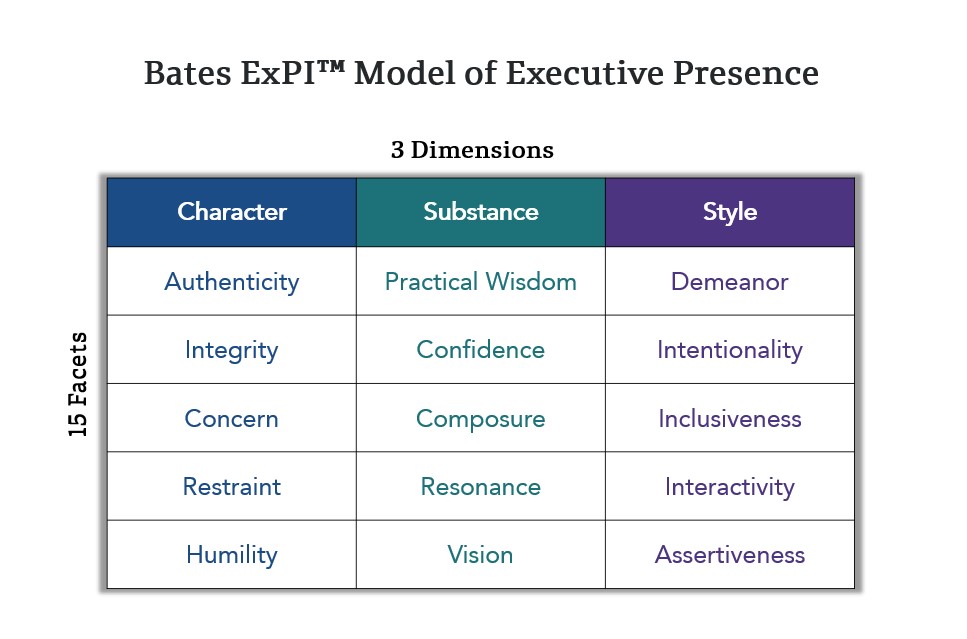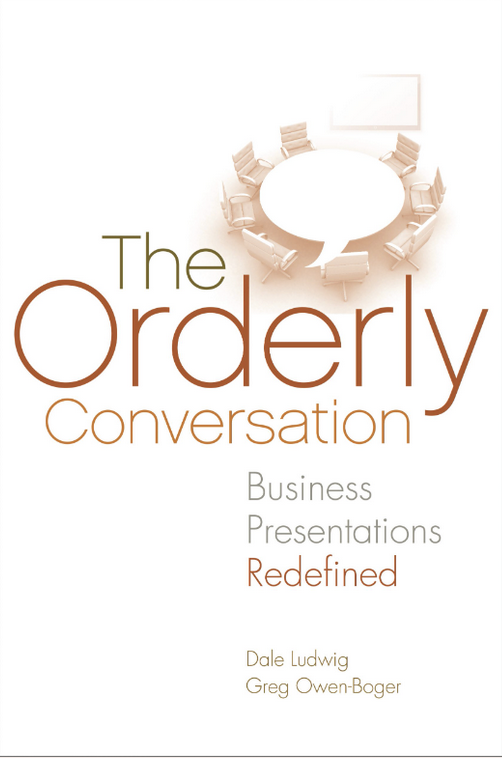
- Dale Ludwig Leadership
Fifteen Facets in Action
Executive presence is difficult to define. We all know it when we see it, but what IS it exactly? Gravitas? Charisma? Owning a room? We’ve heard these descriptions time and again, but they don’t really get at a useful definition.
For those of us in communication development, this lack of clarity about what executive presence is—what it looks like, what it feels like to others—has been a huge challenge. After all, would YOU know how to coach someone to improve their charisma or gravitas? What’s needed is a definition built on specific attributes that can be observed and developed.

In this book, Bates and her partners share the results of their research from across industries and the world, resulting in a practical definition of executive presence. They paint a picture of the observable behaviors practiced by effective leaders and do so without falling into the trap of promoting stereotypes.
This article is an overview for fifteen more articles, each dedicated to a single aspect of executive presence, as defined by Bates. Through these articles, we will answer these questions:
- What is executive presence?
- What does it mean for me?
- How can I communicate in the workplace in a way that improves my executive presence?
By answering these questions, we’ll offer real-world recommendations for developing your executive presence and advancing your career.
The Definition of Executive Presence
Bates defines executive presence as: “The qualities of a leader that engage, inspire, align, and move people to act.” Executive presence, then, is about getting people to do something, to change their perspective or behavior. It’s also about how a leader makes others feel, an emotional response.
Here’s what I mean. Bates does not say that executive presence is about the qualities of a leader that encourage people to understand or agree. These are thoughtful, logical responses to what someone says. What Bates writes about is more than that. Her definition focuses on how people feel about understanding or agreeing. There is an emotional punch associated with “engage, inspire, align, and move people to act.”
These feelings are important because they lead to responses like these
- I can trust this person
- This person genuinely cares about me
- This person has my best interests at heart (making good use of my time, making me feel part of this group, understanding my perspective, respecting me)
- This is an honest person, one who is humble, respectful, and knows where we should go
- I am willing to follow this person because we’re doing the right things
With goals like these in mind, it’s clear that executive presence is not just about your intentions. It’s also about people’s reactions to you. We don’t simply decide one day to be trustworthy, for example; we have to prove it to others over the course of time. As Bates puts it, you must understand “how your intentions as a leader match up with perceptions, (so that) you can learn how to flex your style to gain trust, build alignment, lead change.” In other words, executive presence requires not only improving your self-awareness and your awareness of others, but also understanding the cumulative impact your communication and behaviors have on the people you work with.
…executive presence requires not only improving your self-awareness and your awareness of others, but also understanding the cumulative impact your communication and behaviors have on the people you work with.
From Our Perspective
Bates’ description of how executive presence is developed aligns nicely with our approach to communication skills development. If you know our work, you know we believe that business communicators succeed on two levels. The first level has to do with achieving the goal of a particular communication event. Selling an idea, persuading someone to think in a new way, gaining alignment, and training a new skill are all examples of first-level success.
The second level has to do with how the first-level goal is achieved. It focuses on the communication process and how listeners respond to it. Compared to the relatively simple determination of whether the first-level goal was reached (Did they agree? Buy? Understand?), the second level is much more visceral and emotional. It has to do with making others feel as if they’re in good hands with you, generating reactions like these
- The meeting facilitator created an environment in which attendees felt comfortable, heard, and willing to participate
- The presenter made it easy for everyone to follow along and understand
- The facilitator built trust and goodwill
These reactions are the result of how the process of communication is managed and how other people respond. All of this contributes to a person’s executive presence.
This series of articles will bring together our work as communication experts and Bates’ approach to executive presence. My focus will be on how your executive presence can be developed and strengthened in the conversations you hold, the meetings you facilitate, and the presentations you deliver.
Introducing the Three Dimensions and Fifteen Facets of Executive Presence
Bates and her partners identified fifteen attributes that effective leaders possess. She calls these attributes “facets,” and she places them into categories she calls “dimensions.” Here’s an overview of the three Dimensions.
- Character: “The qualities we learn early in life that are key to building trust”
- Substance: “The qualities that leaders develop as adults and that are important for establishing credibility”
- Style: “The qualities used in two-way communication to get people aligned and drive execution”
Here’s how the fifteen facets fall within the three dimensions.
How to Think about the Facets
- Everyone is unique. It’s interesting to note that all effective leaders and communicators possess all of these facets, but how they show up is different for everyone. This explains how two people can both have strong executive presence without losing their unique personalities.
- The facets go beneath the surface. One of the challenges surrounding the idea of executive presence is that too often it focuses too much on appearance. While appearance plays a role in Bates’ model (it’s part of the Demeanor facet), it is no more important than any other facet. Further, she talks about Demeanor in terms of how it affects other people. For example, do you appear healthy, well-groomed, and appropriate for the situation? As with all the facets, success is determined by another’s perception of you in a particular context.
- Improvement requires self-awareness and thoughtful change. In other words, leaders need to be intentional with their behaviors. Being intentional in this way should not be confused with Intentionality (one of the facets). The type of intentionality I’m talking about here has to do with being deliberate about how you want to improve your executive presence. As a facet, Intentionality is about communicating clearly and with purpose.
- It’s possible to have too much of a good thing. When you have an overabundance of a particular facet, it’s called an overstrength. Overstrengths result in negative perceptions. An easy way to understand this is by examining assertiveness (one of the facets). Effective leaders are assertive in just the right amount. If they push too hard, their assertiveness can be perceived as aggression or even hostility. Over time, an overstrength in assertiveness can be grating and demoralizing to coworkers. So instead of leaning into this facet, an executive with an overstrength in assertiveness needs to pull back from it.
About this Series of Articles
Now that the foundation for understanding executive presence is laid, we can examine each of the facets in more detail. As mentioned above, we have written an in-depth article on each of the fifteen facets. In these articles, we’ll examine how Bates defines each facet and the communication skills and behaviors that support them. Click a facet to learn more about it.
| Character | Substance | Style |
|---|---|---|
| Authenticity | Practical Wisdom | Demeanor |
| Integrity | Confidence | Intentionality |
| Concern | Composure | Inclusiveness |
| Restraint | Resonance | Interactivity |
| Humility | Vision | Assertiveness |
If you’d like to learn more or explore executive presence coaching options for yourself or your team, click here to schedule a call.


